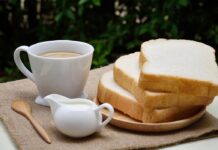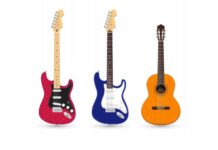Harmonica, also known as harp, is a musical instrument. It is a timeless instrument, and the best harmonica in Canada is determined by your level of expertise. A different level of harmonica is needed if you are a beginner.
Harmonicas are of two categories
There are two harmonicas that get used far more than any of the others, out of all the fun varieties, flavours, and sounds available:
Diatonic:
By far the most common, Diatonic Harmonicas are what most people think of when they think of a Harmonica. Since they include all of the notes of a single scale, nearly every Harmonica player ends up with several Diatonic Harmonicas, one for each chord. It can be found in Rock, Blues, Country, and a variety of other musical genres. If you’re just learning to play the harmonica, this is the way to go.
Chromatic:
Chromatic Harmonicas are distinct in that they have a greater number of notes that span the entire chromatic scale. Since there are so many more notes to choose from and not all of the notes are in the same scale, they take a little more discernment in choosing which note to play. These are usually large harmonicas that are only known to those who have a basic understanding of the instrument and its variants. Many who learn to play the Chromatic are often found playing Jazz, which is a sight to behold.
The difference between a diatonic and a chromatic harmonica is the number of notes available. The disparity between those who play which one is skill level and knowledge of music theory.
Other types of Harmonica:
Tremolo Harmonica
The third major type is the tremolo harmonica, which has the capacity to play two reeds at the same time. It is notable that the pitch of these reeds varies as one is sharper and the other is flat. Some often consider this effect to highlight the changes in the song’s pitch despite playing the same note all over again. Tremolo harmonicas tend to be popular in East Asia as part of their folk music compositions.
Tremolo harmonicas are not seen too often in many western settings because playing a scale may be difficult and honestly quite confusing for beginners. The notes are in a different order than the piano, for instance, which makes mastering the music theory behind it all the more difficult.
However, if you’re looking for a challenge, a tremolo harmonica might be the instrument for you.
Orchestral Harmonica
Specialized harmonicas are also available, but they are only used for special occasions in this case. The orchestral harmonica is the most well-known unique harmonica, since it is only used in orchestral performances. This harmonica assists players in controlling the song’s range and pitch as well as changing keys.
ChengGong Harmonica
Understanding the Origins of Harmonicas and Early Versions of the Instrument will help you appreciate the next Harmonica in sequence.
There’s also the ChengGong harmonica, which is a kind of Asian harmonica. This harmonica has a main body as well, but instead of having a fixed or steady mouthpiece, it has a sliding mouthpiece.
This harmonica is a diatonic diatonic harmonica with 24 holes that covers three octaves. The 11th hole on the harmonica will slide along the instrument to create a variety of chords.
It can also play a single note tune, similar to a standard harmonica. Since this harmonica can only produce the same note each time, you can’t play different notes by blowing and drawing in the same place.
Pitch Pipe
The pitch pipe is another advanced harmonica on the market. This harmonica is typically used to guide singers and other musicians as to which pitch to follow.
Pitch pipes are now divided into two types: chromatic pitch pipes for choirs, which can play 12-note octaves, and pitch pipes for string players, which are used to tune the open strings on their instruments.
Glass Diatonic Harmonica
A glass variant of a diatonic harmonica was invented by Geoff Stengel in 2009. The glass components on this harmonica make it a diatonic harmonica. The glass in this case is borosilicate to ensure that it does not crack easily.
Each reed can be replaced, and the whole thing is kept together by brass screws. The color of each part of this harmonica is achieved by hand mixing oxides and borosilicate glass to achieve the desired effect.
Electric Harmonica
Finally, electric harmonicas are now available on the market. This harmonica appears to be identical to the harmonicas currently on the market.
This sort of harmonica, on the other hand, has a microphone built in to ensure that the sound it produces is louder without the use of an amplifier. Richard Smith, the inventor of Harmonix Harmonicas, is the owner of the patent for this type of harmonica.
Bass Harmonica
The bass harmonica is one of the lesser-known harmonicas. It’s available in a few different versions, and it’s just what it sounds like: the bass harmonica plays those low notes, making it a deep accordion sound rather than a chipper higher pitched sound.
Bass harmonicas are mesmerizing instruments to listen to and watch people play. They aren’t a perfect starting point because they aren’t widely used or used.
The Six-Sided Harmonica
The Hohner Kreuzwender Six Sided Tremolo, or novelty six-sided harmonica, is the world’s first and largest harmonica. This solid device is the first and most special of its kind, measuring 11”x3 12” in diameter and weighing around 1 pound.
Which Harmonica Should You Purchase?
For most of the guidance and lessons here, a typical 10-hole diatonic harmonica in the key of “C” is best (other key harmonicas come later). Tremolo harmonicas are double-rowed harmonicas with eight, ten, or twelve sets of double holes. They are not the right sort of harmonica for our lessons. To learn more about the distinctions between diatonic and chromatic harmonicas, click here.
Key of “C” Diatonic (standard 10-hole) Harmonica- You’ll need a good quality diatonic type harmonica to learn and practice on with hole numbers imprinted above each hole. The standard 10-hole diatonic harmonica is used for most blues, folk, rock, and country styles (of course you would need a standard chromatic harmonica if utilizing our chromatic harmonica instruction).
Stick with a basic 10 hole harmonica in the key of “C”- Diatonic harmonicas come in all twelve keys (G, Ab, A, Bb, B, C, Db, D, Eb, E, F, F#), but for beginners it’s easier if you start with a basic 10 hole harmonica in the key of “C” (generally speaking, the “G” harmonicas are very low and the “F” and “F#” harmonicas are very high pitch-wise, while the “C” is right in the middle). Key of “C” harmonicas are the most common, and they also make understanding music theory much easier.
Should I buy other key diatonic harmonicas as well?
As you improve and begin to play with others or start playing along with CDs, you will want to pick up some of the other key diatonic. The “C”, “A”, “D”, “F”, and “G” keys are a good place to start- in roughly that order. The key of harmonica you need is determined by the key the song is in and usually set by the singer. If you are not playing along with other people or with CDs, all you need is a key of “C” for now.
Additional harmonica keys
Pick up additional keys when you are ready to play with others and jam with CDs.
A cheap harmonica is tough to learn on- Prices may vary, but it is best to buy a diatonic harmonica for no less than $35 to $60, because a cheap harmonica can be extremely difficult to learn on. Poor construction of inexpensive harmonicas causes them to leak air and makes them hard to play and difficult to learn important techniques like bending.
Avoid these diatonics, and possibly “upgrade”- Avoid inexpensive wood combed harmonicas if you are just starting out for the same air leak problems mentioned above. The “free” harmonicas that are included with less expensive book and harmonica packages are not recommended either. These are very inexpensive harmonicas that are included in the package for convenience, but are typically of low quality. If you have any serious intentions at all with the harmonica, you should upgrade to a better harmonica.
Should I buy a used one? This is entirely up to you. But, we don’t recommend it for obvious health reasons, and the fact that a brand-new pro quality diatonic is between $35 and $60. Also, harmonicas do wear out over time. It’s best to start with one that you know is in good condition and plays in tune.
So, while purchasing a harmonica keep in mind that your usability understanding will help you purchase the best.
1. Suzuki SU-MR250C Bluesmaster Harmonica C
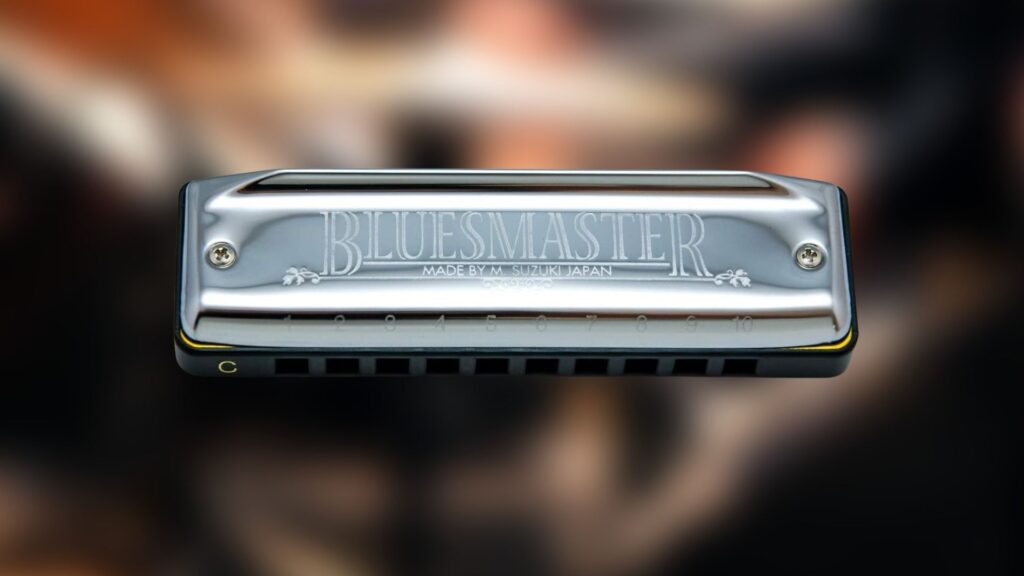
Suzuki harmonicas are of the highest quality, and they are the product of a Suzuki tradition of continuous improvement of manufacturing processes and a never-ending quest for new ideas, all backed up by the legendary high standards of Japanese craftsmanship, resulting in a pleasing balance of tradition and creativity.
The new Blues master combines the affordability of our famous Folk master with the world-renowned Promaster to create an easy-to-play, easy-to-own skilled harmonica. Stainless steel covers are long-lasting and ergonomically constructed to make them easy to use.
Phosphor Bronze reeds and an ABS plastic comb have excellent sound projection and tonal clarity on the inside. The tough new Blues master is practically unbreakable. With the SUZUKI Blues Master, you’ll look good, sound good, and feel good.
This is a fantastic harmonica with 16 holes and 64 cross-aligned notes. The key of C is played on the harmonica. It can play any song that you like. It is extremely accurate, elegant, and long-lasting. The harmonica has a very soft lining case and an ergonomic design. If you don’t already remember, C is a major scale played with a mouthpiece.
Pros:
- Decent Quality.
- Good for beginner.
- Sound really great.
Cons:
- Overpriced.
- Less holes than expectations.
2. Clearly Colorful Translucent Harmonica
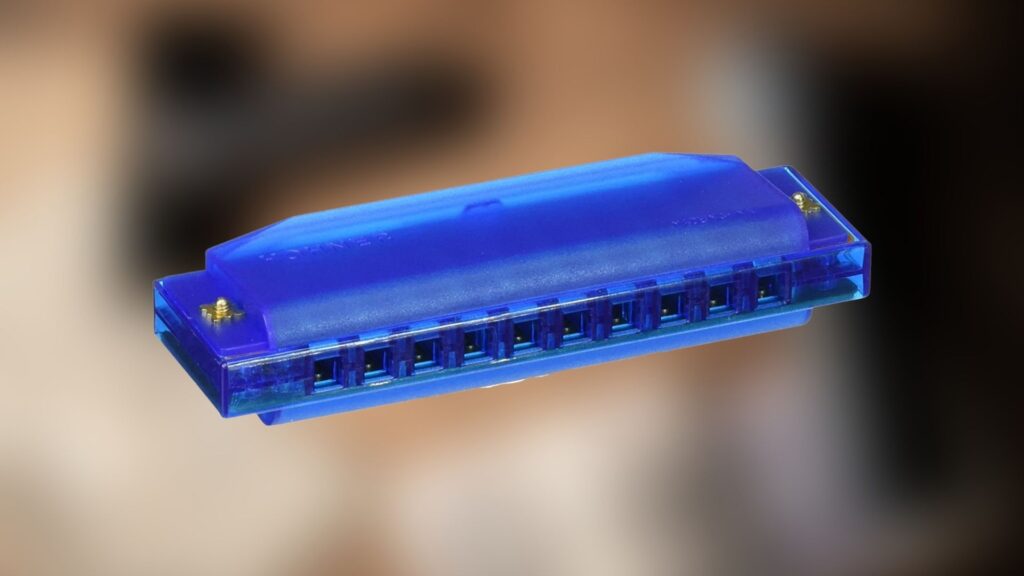
HOHNER has been making the highest-quality musical instruments in the world since 1857. To name a few, we make harmonicas, accordions, melodicas, recorders, guitars, and ukuleles.
It is the best harmonica in Canada for beginners. It is transparent and inexpensive, and children as young as three can use it. The fact that it comes in a variety of colours is appealing. It can be difficult to blast at times, but it is still a great peace to play your cheerful tones.
Pros:
- For instance, it’s affordable and convenient.
- The ability to perform.
- It’s ideal for a classroom band.
Cons:
- It’s perfect for children, but I’m not positive about adults.
3. East top Chromatic Harmonica
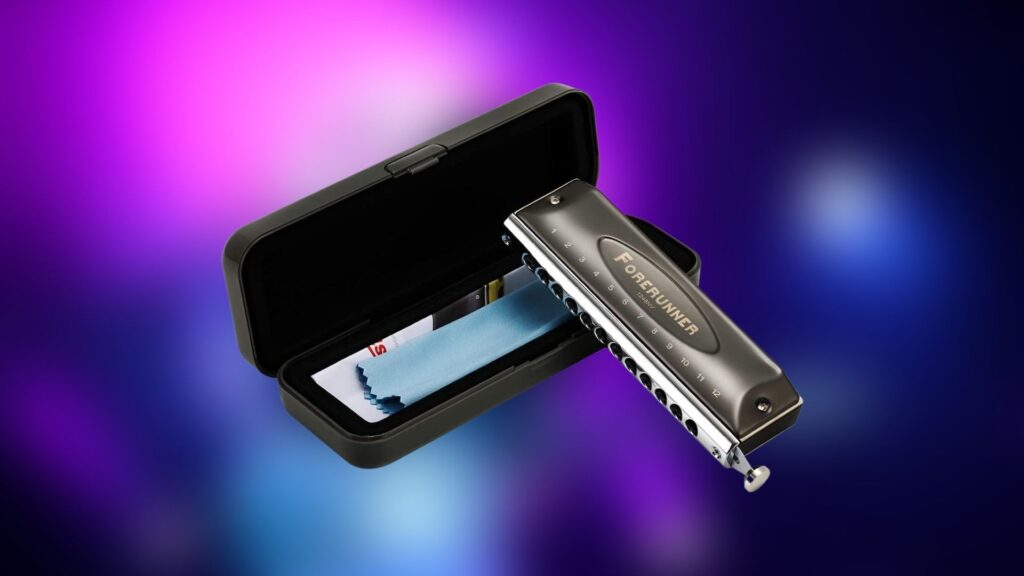
12-Hole 48 Tones C Key Mouth Organ Forerunner Harmonica for Adult, Professionals, Students and Band Players.
East top 12hole chromatic harmonica. This chromatic harmonica is suitable for many occasions, and is suitable for beginners and professional band players, adults and students.
It’s easier to get higher pitch, rich tone, and timbre with the precision-made plastic comb with phosphor bronze reed&1.2mm thickness reed plate. After electroplating, the reed plate is antirust, and the hole and reed gap are improved.
You will feel at ease when performing, and the ability will be simple to master, providing the artist with a new experience. It is small enough to fit in your pocket and can be played anywhere, such as at a party, school, workplace, or on a flight.
Pros:
- Good for the Price
- Comes with a well-made case
- Proper instructions provided.
Cons:
- Issues may occur with the quality control
4. Fender 099-0701-049 Blues Deluxe Harmonica
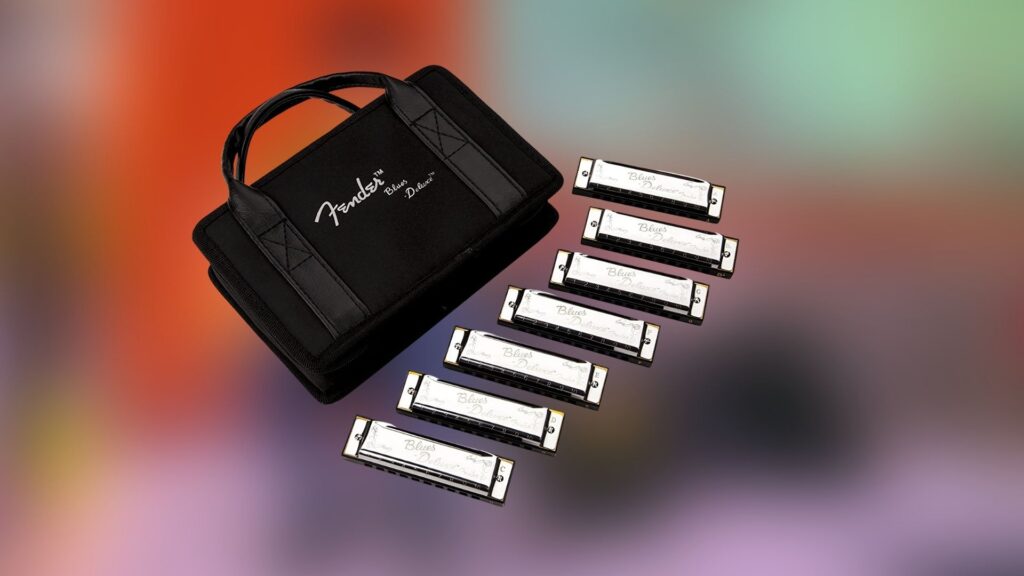
The Fender Blues Deluxe harmonica is built to appeal to players at all skill levels. A moulded PVC comb and brass reeds provide the instrument’s classic tone and pitch. Your harmonica will be relaxed and simple to play thanks to its traditional form and chromed metal covers. Reed plates may also be replaced. A vented hard plastic case is included.
Seven different harmonicas in the keys of C, D, E, D, E, F, Bb are included in the seven-pack harmonica. People who play all the keys will play and buy this mouthpiece because it is built for personality. The body is made of chrome metal, and playing it is very easy and comfortable.
The Fender Blues Deluxe Harmonica is flexible enough for any level of musician, whether you’re a professional harpist or just getting started. This diatonic 10-hole harmonica has the classic sound and long-lasting durability of any genuine Fender instrument, with sturdy construction, a typical form, and a vivid, articulate tone.
Pros:
- Excellent for beginners.
- It’s sturdy, smooth, and enjoyable to play.
Cons:
- As opposed to higher-quality items, it’s big and clumsy.
5. Swan Silvery 10-hole 40 tone chromatic harmonica

A chromatic harmonica of professional standard. Swan, one of the most well-known harmonica makers, produced these instruments.
The harmonica is packaged in a comfortable solid plastic display case with a cleaning cloth, making it an excellent gift.
The harmonica has ten holes and a slide, allowing for a total of 40 notes. This is a fun instrument, with brass reeds and a plastic central section that forms the holes (plastic is far more durable than wood in this situation).
The top and bottom sections, as well as the front plate and slide, are chrome plated and can be unscrewed for cleaning and maintenance.
Please keep in mind that a chromatic harmonica can play all musical notes, even semitones. This is accomplished by using the slide; without it, you can play in the key of C major, but pressing the slide in unlocks a new collection of notes that contains the missing semitones from the major scale.
This is more difficult to learn than a tremolo or diatonic harmonica due to the slide, but it is much more flexible.
The main feature is the brass reads section, which is combined with a plastic central section to make it play cute. The harmonica is long-lasting and a must-have item.
Pros:
- Suitable for newcomers and practice.
- The quality is outstanding.
Cons:
- The sound isn’t what you’d imagine.
- It’s a little difficult to learn in this.
6. Hohner Special 20 Harmonica

Amazing response, incredible bendability, and the sweetest tone you’ve ever heard. This is the harp of choice for those who are just learning to sing. It is the most recommended go-to harp for harmonica players of all styles, including blues, country, folk, and rock, due to its unique airtight nature.
The plastic comb doesn’t absorb moisture making it longer lasting. Harp of choice of harmonica virtuoso John Popper (of Blues Traveler) and played by Bob Dylan on his 2007/08 tour. Chances are your favorite player has several of these harps in his case. 12 major keys plus lower and higher octave tunings. It is approximately “4 inches” long.
It has a silky smooth body and reads that are fast. It is a German product with a stunning style and body. The stainless steel cover plate of the diatonic harmonium is a diatonic harmonium. So, if you’re looking for something to buy that has a unique design, is easy to transport, and is enjoyable to play, this is the best option.
Pros:
- There’s a lot of volume and a great tone to it.
- It’s easy to pick up and play.
- Hot, rich, and sweet tones.
Cons:
- Paying a high price.
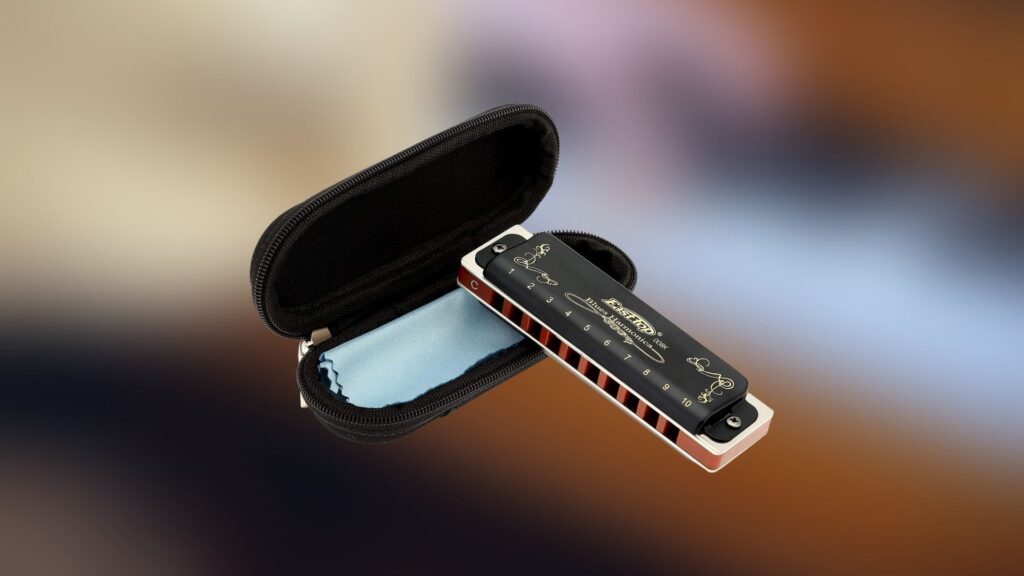
Blues Harmonica Key of C 10 Hole 20 Tone Blues Mouth Organ Diatonic Harmonica Adult Blues Harp Musical.
East top 10-hole professional diatonic harmonica for musicians, perfect for Blues, Folk, Rock, Country, Jazz, and more, great for harmonica players, beginners, and kids. This Professional Blues Harmonica is well-made, has a lovely sound, a clear tone, and is sensitive. Guitars, violins, flutes, and other musical instruments can all be used to play this blues harmonica.
The precision-made plastic comb with phosphor bronze reed&1.2mm thickness reed plate makes it easier to achieve higher pitch, rich tone, and timbre. After electroplating, the reed plate is antirust, and the hole and reed gap are improved. At the same time, you can feel at ease when playing, as the skills, such as over-blowing and bending, are simple to use and provide the artist with a new experience.
Pros:
- Excellent sound quality.
- Awesome price.
- Pretty appearance.
Cons:
- The inlay in the combs may irritate some
8. Fender 0990702001 Blues Deville Harmonica
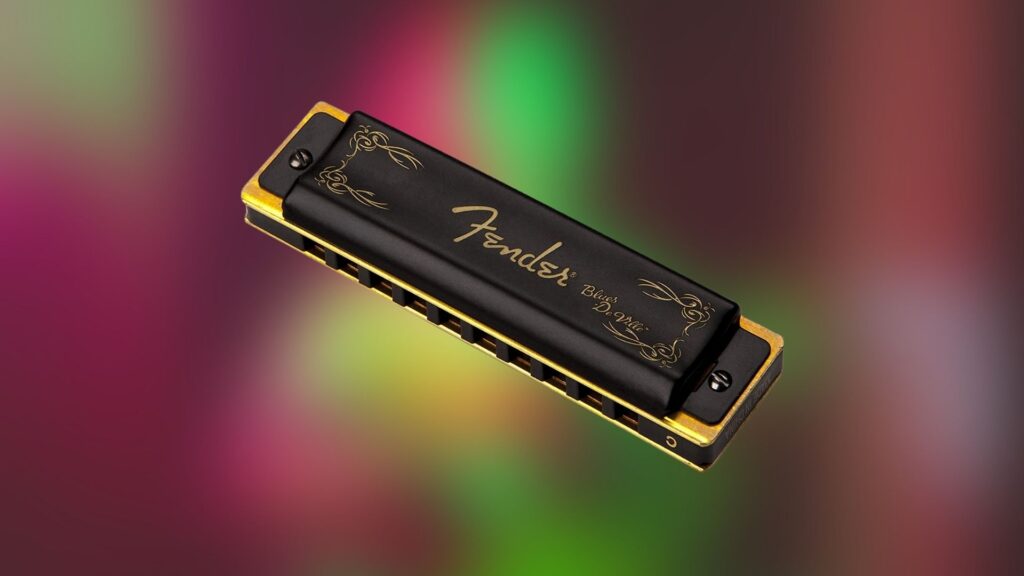
The Fender Blues Deville harmonica is designed to sound as good as the Fender name implies. A moulded PVC comb and precision phosphor bronze reeds allow for a richer tone and pitch. Your harmonica will look as good as it sounds with its traditional shape and black satin covers. Reed plates may also be replaced. A vented hard plastic case is included.
This is a one-of-a-kind, incredible harmonica designed to play in the key of C. It comes in brown and gold and appeals to ice. The sound is nice, as the name suggests. It has a deep tone and a high pitch.
Pros:
- Nice Quality Harmonica.
- Easy to Learn.
Cons:
- Overpriced.
9. Mugig Harmonica, C Key Harmonica for Beginners or Kids
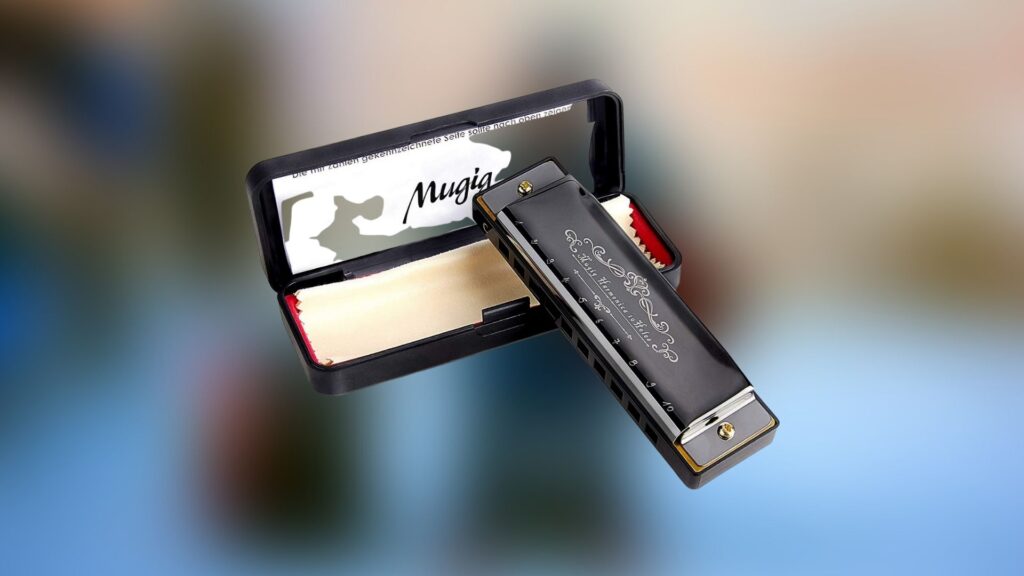
Blues, folk, and pop music can all be played on the C key harmonica. Ends are fully sealed, reducing air leakage. The tone 10 Holes 20 Tones is a decent choice for training and beginners with guidance.
Stainless steel is used to build the case. The harmonica has phosphor bronze reeds and an ABS resin comb structure, making it washable and sturdy. The mugig harmonica measures 4.3 x 1.57 x 0.98 inches and weighs 0.2 pounds. Perfectly sized for carrying or stowing in a bag.
This is the best harmonica to buy if you only want to play it as a hobby. It has a chromium finish and is elegant. It produces a beautiful and consistent voice. Phosphor bronze reeds are used on the harmonica. The cover is made of stainless steel.
Pros:
- Great as practice harmonica.
- Awesome sound.
Cons:
- Hard to play.
10. Lee Oskar 1910-C Harmonica
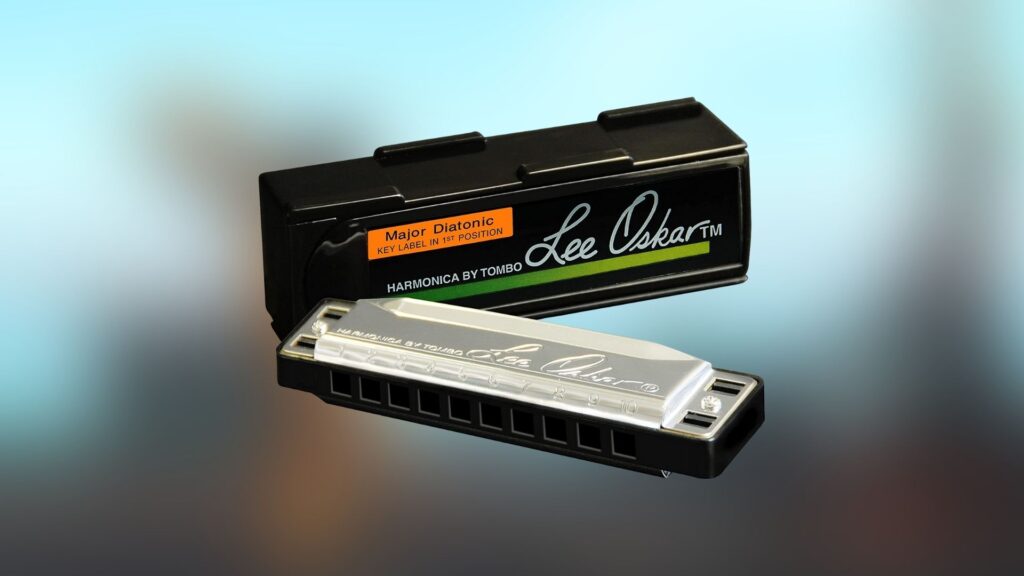
The major diatonic harmonica is the most commonly used tuning for playing blues, rock, country folk and jazz. Major diatonic harps are produced by several manufacturers using various names such as blues harp, marine band, golden melody, big river, special 20, pro harp, folk master, star performer, etc.
Although the cover plates are stamped with a variety of different names for marketing purposes, all of these harmonicas have the exact same notation layout as the lee Oskar major diatonic.
The most important difference is in the quality of materials, construction, design and sound. Lee Oskars are the best harmonicas in the world, and that’s not just our opinion. All over the world, professional players prefer lee Oskar harps over any other brand.
It is amazing and especially preferable to play rock and blues. It comes with a plastic comb and has 10 large holes for easy playing. The harmonica is made with an airtight design and responsive reads. Another interesting point here is that the reed plates are replaceable. If you are an intermediate player then this is the best mouthpiece for you.
Pros:
- Fun to play
- Great for beginners
- Great sound
Cons:
- Lightweight and cheap construction
11. AKLOT Blues Harmonica 10 Hole Diatonic

It is made up of phosphorus bronze reeds and can play flawless tunes. Apart from this the mouthpiece has 11 screws for strong fixation and is made up of thick stainless-steel cover. Even if it falls not a problem. This is a diatonic, 10 whole harmonica that can play almost 20 tons. It is especially for adults and beginners.
The Blues harmonica uses high-sensitivity phosphor bronze reeds, non-toxic food-grade ABS resin Comb and copper cover that can amplify sound resonance
This Blues harp has 11 screws to strengthen fixation, thicken stainless steel covers wrap the copper reed plate tightly, not easy to deform and fall apart after long-term use.
Phosphor Bronze Reeds offer sensitive pronunciation and stable interval. Carefully Riveting inside ensures the quality and achieves a pure, beautiful, and mellow harmonica sound.
The Blues has already tuned by experienced craftsman before out of factory, you will get accurate tone. Beginner’s best choice.
Pros:
- Well made
- Nice sound
- Easy to play
Cons:
- may not look as classy.
- watch out for sharp corners.
12. Suzuki HA-20-C Promaster Hammond Professional
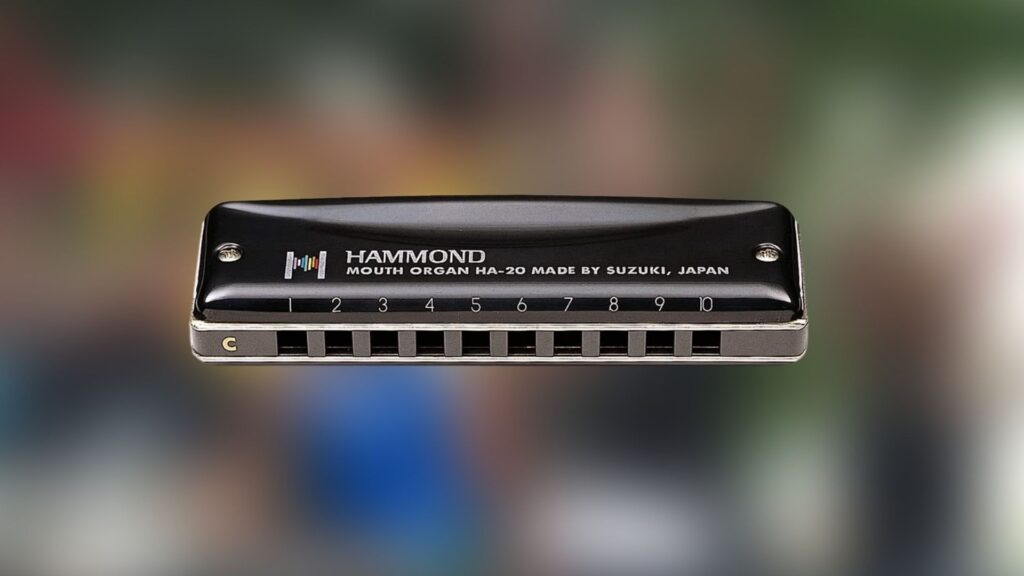
Have you ever wished for a pocket-sized Hammond organ? You’ve come to the right place. The coloured Hammond logo on the HA-20 harmonica stands out against the black shell. You will get hooked to its beautiful sound almost immediately. Phosphor Bronze reeds are used in the HA-20, which also comes with a hard-shell carrying case.
It’s a 10-hole gadget that comes in a variety of keys, including A, Bb, and C. It’s a Suzuki harmonica from Japan. This is the best harmonica in Canada for people who want to take their singing to the next stage. It comes with a case and has simple numbers on the frame. The downside is that it can be difficult on the lips at times.
Pros:
- Great Quality.
- Worth the Cost.
- Sounds great.
Cons:
- Not easy to play.
13. Hohner 1896BX-C Marine Band
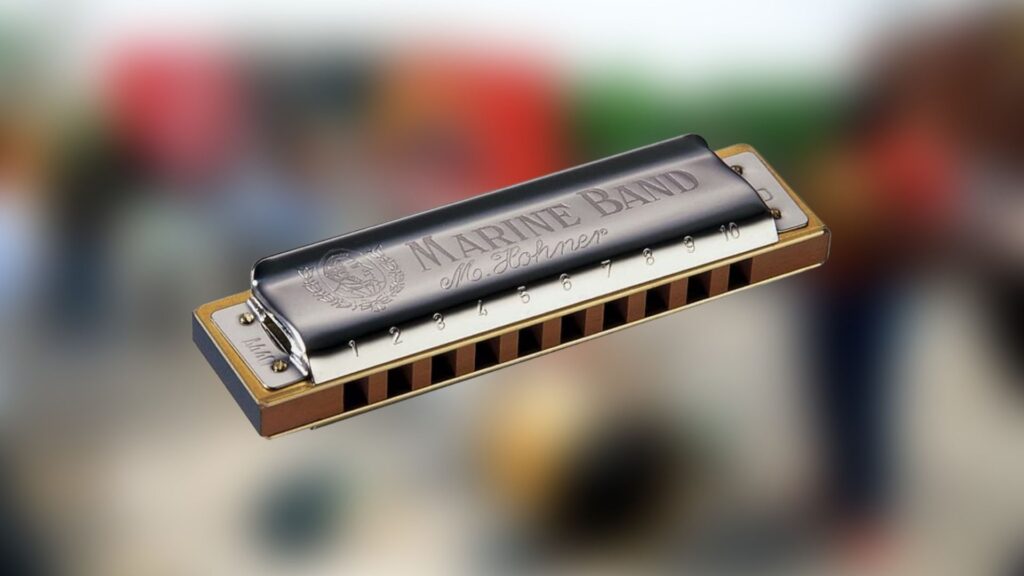
This is a very famous and recognizable mouthpiece in the world. It is played by most of the musicians including Bob Dylan, little Walter, Bruce Springsteen and Neil young. It is protected by its history and fame. It is durable, made up of good quality and preferable for everyone. You will be surprised to note that it is a handmade piece made up of brown paper would comb
Pros:
- Great value for money.
- Amazing sound.
Cons:
- Slightly overpriced.
Final Thoughts:
This was a list of 13 best harmonica in Canada. One of the most prominent harmonicas is AKLOT because of its amazing functioning, body and durability. Apart from this, you can also purchase Hohner marine band 1896 historic harmonica that is played by various popular personalities. Now it’s your choice to select one that’s best for you.
People Also Look For:
– Best Electric Guitar under 1000


